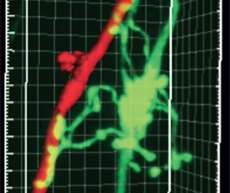3D image of a mossy fiber in green contacting the dendrite of Golgi cell in red. The green connections are formed during learning and are critical for the precision of learning.
(Medical Xpress) -- Scientists at the Friedrich Miescher Institute for Biomedical Research (FMI, part of the Novartis Research Foundation) have discovered neuronal connections which are formed in the brain when learning occurs, and which ensure the precision of memory. This work represents an important step on the path towards an improved understanding of how learning and memories are stored in the brain. The findings were published today in the online edition of Nature.
How are experiences and learning stored in the brain? This "simple" question has intrigued scientists for several generations. Since the visionary neuroscientist and Nobel laureate Santiago Ramón y Cajal first postulated (at the end of the nineteenth century) that structures in the brain change during learning, and that what is learned - or the memory of what has been learned - is represented in neuronal connections, researchers have sought to detect structural changes of this kind. They have been searching, as it were, for nerve cells which encode the Pythagorean theorem or the memory of a red dress. So far, their efforts have not been successful, as the sheer number of neuronal connections, or synapses, in the brain has proved an insuperable obstacle.
Neurobiologists at the FMI have now demonstrated a direct link between the formation of new synapses in the brain and a learning process, plus the quality of the associated memory. These findings were reported today in the online edition of Nature.
A team led by the group leader Pico Caroni, who is also a professor at the University of Basel, studied neurons in the hippocampus of mice learning to navigate a water maze. The hippocampus is a region of the brain which is essential for learning and recall.
During learning, the number of synapses onto interneurons was found to double along hippocampal mossy fibers. These new synapses indirectly inhibited other cells, known as pyramidal neurons, thereby contributing to the precision of what was learned. They thus laid down, for example, that at a certain point in the maze, the mouse should go to the right, but not to the left, straight ahead, back, up, or down. When the formation of these synapses was inhibited by the administration of a drug, the mouse would still find its way, but with less precision - it did not take the shortest route to the goal.
Caroni explains: "Our experiments have, for the first time, demonstrated a clear association between the formation of new synapses and behavior after learning. So we've shown a specific structural change in the brain induced by learning - and also that this change is required for the precision of learning."
The researchers also found that the newly formed synapses often disappeared again several days after the end of the learning process. However, even weeks later, this did not prevent the mice from navigating the maze successfully, although precision was diminished. "What we've discovered," says Caroni, "are not structures which are indicative of memories, but structures which are necessary for precise recall of what's been learned. If these mechanisms are disrupted, behavior can be diverted by more dominant stimuli, which could play an important role in many memory disorders."
More information: Learning-related feedforward inhibitory connectivity growth required for memory precision, Sarah Ruediger, Claudia Vittori, Ewa Bednarek, Christel Genoud, Piergiorgio Strata, Benedetto Sacchetti & Pico Caroni, Nature (2011) doi:10.1038/nature09946
Abstract
In the adult brain, new synapses are formed and pre-existing ones are lost, but the function of this structural plasticity has remained unclear1, 2, 3, 4, 5. Learning of new skills is correlated with formation of new synapses6, 7, 8. These may directly encode new memories, but they may also have more general roles in memory encoding and retrieval processes2. Here we investigated how mossy fibre terminal complexes at the entry of hippocampal and cerebellar circuits rearrange upon learning in mice, and what is the functional role of the rearrangements. We show that one-trial and incremental learning lead to robust, circuit-specific, long-lasting and reversible increases in the numbers of filopodial synapses onto fast-spiking interneurons that trigger feedforward inhibition. The increase in feedforward inhibition connectivity involved a majority of the presynaptic terminals, restricted the numbers of c-Fos-expressing postsynaptic neurons at memory retrieval, and correlated temporally with the quality of the memory. We then show that for contextual fear conditioning and Morris water maze learning, increased feedforward inhibition connectivity by hippocampal mossy fibres has a critical role for the precision of the memory and the learned behaviour. In the absence of mossy fibre long-term potentiation in Rab3a−/− mice9, c-Fos ensemble reorganization and feedforward inhibition growth were both absent in CA3 upon learning, and the memory was imprecise. By contrast, in the absence of adducin 2 (Add2; also known as β-adducin)10 c-Fos reorganization was normal, but feedforward inhibition growth was abolished. In parallel, c-Fos ensembles in CA3 were greatly enlarged, and the memory was imprecise. Feedforward inhibition growth and memory precision were both rescued by re-expression of Add2 specifically in hippocampal mossy fibres. These results establish a causal relationship between learning-related increases in the numbers of defined synapses and the precision of learning and memory in the adult. The results further relate plasticity and feedforward inhibition growth at hippocampal mossy fibres to the precision of hippocampus-dependent memories.
Provided by Friedrich Miescher Institute for Biomedical Research





















